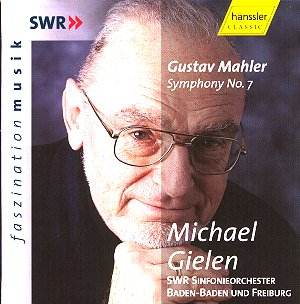Mahlerís 7th is generally thought of as
the most problematic of his symphonies. Many people fight shy of it,
and this is understandable; it is perhaps the most psychologically complex
of the nine (or ten if you will). It has no clear-cut conclusion, and
you wonít find here the religious affirmation of the 2nd
and 8th, the sense of hard-won achievement of the 5th,
or the uncompromising tragedy of the 6th. Indeed, it can
be hard to know just how to feel at the end of the finale. The welter
of sound is of course overwhelming, but, in the end, the effect is almost
of exasperation. It is in many ways one of the composerís least successful
movements, suffering from too many starts and stops and crashing changes
of gear. A pity, because the first four movements are magnificent, and
amongst the best things he did.
The work has inspired many fine recordings. Bernstein,
Rattle and Abbado have all produced distinguished versions, while there
have been historic performances from Horenstein and, in particular,
Hermann Scherchen. The present recording was made in 1993, but was hard
to come by until recently. Now Hänssler have reissued it, and it
is without doubt an impressive contender, right up there with the best.
Gielen is himself a fine composer, and has got right inside the sound-world
of this symphony. All the orchestral effects come off superbly, and
there is also great clarity, though there is nothing clinical or boxy
about the sound. The orchestral playing is special; this is a well-balanced,
virtuoso group, who understand Mahlerís music instinctively, and who
play it with complete mastery, yet with a great sense of the wildness
of the imagination and of the often wicked humour.
The great first movement is given a powerful and convincing
reading. There are one or two quirks; Gielen has looked closely at the
score, and sometimes interprets the string notes Ė for example those
that accompany the opening tenor horn solo Ė as individual semiquavers
rather than tremolando as is normally the case. This gives a strangely
metronomic quality to music that usually shivers rather than stammers
as it does here. One or two climaxes later in the movement find Gielen
apt to rush them impetuously, but this is forgivable, arising as it
does from his intense involvement in the music.
The two Nachtmusik movements are done wonderfully
well, the first one containing notably fine playing from the principal
horn. All the half-lights and subdued colours are captured to perfection.
Similarly, the second Nachtmusik is exceptionally atmospheric;
Mahler has created here one of his most disturbing movements, the chamber
music serenading of woodwind solos and twanging mandoline alternating
with moments of understated terror. The quicker moving, but no less
eldritch Scherzo is given one of the finest readings Iíve heard, with
the orchestra clearly revelling in the weird sounds Mahler calls from
all sections. The flatulent gusts of tuba tone are particularly well
recorded.
Despite my reservations about the finale, this performance
of it held my attention. If anyone could convince me that the movement
hangs together, Gielen could Ė but he canít! The booklet of notes makes
a valiant attempt to suggest that we have here an example of Mahlerís
sense of humour ("always controversial because always hilarious").
I retain my views intact, but have to say that I found this a superb
reading of the work as a whole.
Gwyn Parry-Jones
Tony Duggan also though highly of this performance
in his survey
of recordings of this symphony


